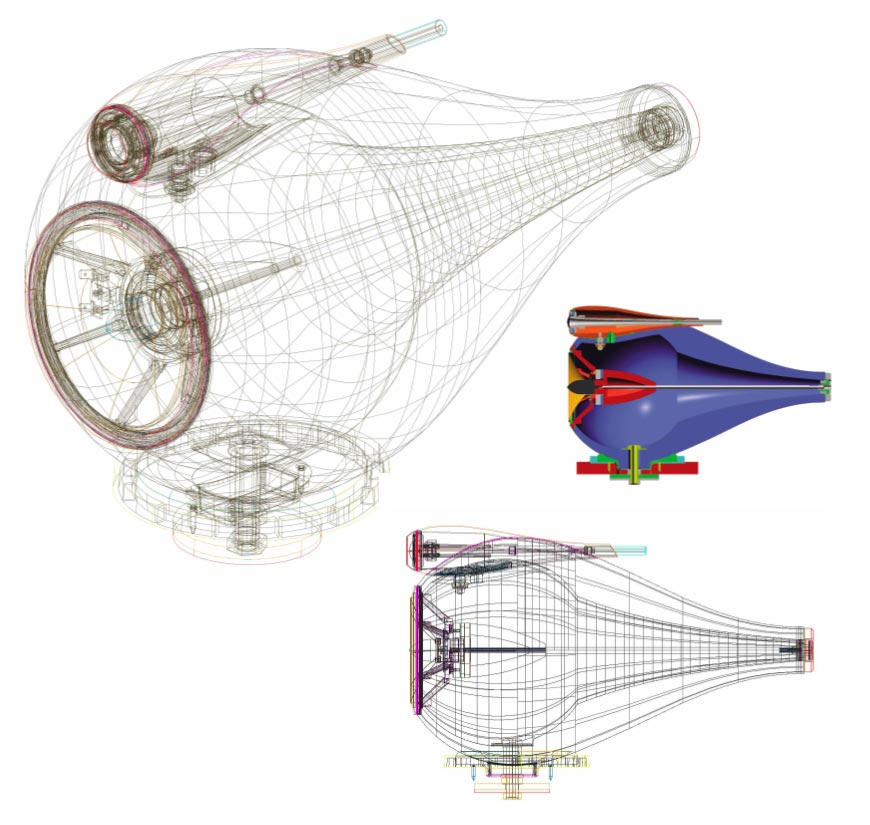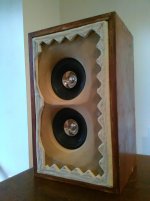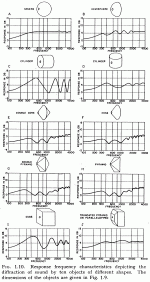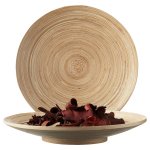Full Range Baffle
Felt is sometimes used around tweeters but not around mid/bass drivers.
Would there be a similar beneficial effect on a driver that produces the full range?
Felt is sometimes used around tweeters but not around mid/bass drivers.
Would there be a similar beneficial effect on a driver that produces the full range?
Last edited:
I was thinking of one or two layers (more effective?) of wool felt as a covering on the baffle. Reaching from the driver edge to the box edges
Last edited:
Depends on the driver and baffle design / dimensions, but yes, to a point anyway you can reduce some diffraction effects that way. Morgan's Arpeggio project has its baffle covered in felt for that reason.
In an ideal world you'd design the baffle to minimise diffraction effects -felt or other surface damping materials are ultimately a band-aid for a sub-optimal baffle design. However, we also need to be realistic & it's usually not possible to produce better-optimised baffles given the the extra work (and skill) required in construction, along with the potentially higher costs. A year or two back I worked up an initial pass at a (relatively) high-end 2-way using a wideband midtweeter and optimised baffle but Dave vetoed full development for the above (perfectly valid) reasons, so we didn't take it any further.
In an ideal world you'd design the baffle to minimise diffraction effects -felt or other surface damping materials are ultimately a band-aid for a sub-optimal baffle design. However, we also need to be realistic & it's usually not possible to produce better-optimised baffles given the the extra work (and skill) required in construction, along with the potentially higher costs. A year or two back I worked up an initial pass at a (relatively) high-end 2-way using a wideband midtweeter and optimised baffle but Dave vetoed full development for the above (perfectly valid) reasons, so we didn't take it any further.
Last edited:
Thanks Scott. I’d love to hear about baffle optimisation. Is a large round over part of that design?
You probably know I’m thinking about the sota 11r
You probably know I’m thinking about the sota 11r
No, but that's certainly one way you can achieve it. Ultimately it's about shaping baffle dimensions and either round-overs or chamfers to minimise diffraction effects (i.e. the amplitude thereof).
Well now I’m interested. Would you mind sharing your thoughts on the ideal baffle for full range?
I’ve edited the thread name slightly 😀😉
I’ve edited the thread name slightly 😀😉
Sorry, I seem to have given a misleading impression. Other than a sphere or hemisphere, there isn't any single 'ideal baffle' per se in this context. In most practical circumstances, what you do to minimise audible diffraction effects will vary from driver to driver depending on their size and on / off axis response curves (i.e. their polar response with frequency). Olson provides some examples of diffraction effects from general forms, and those give a reasonable starting point if you have the freedom to adjust the shape & form factor of the baffle as desired. You can simulate the diffraction behaviour of different baffle forms with something like the Edge, Basta, VituixCAD etc.
Last edited:
Is this the info you mentioned from Olsen? The truncated pyramid looks the best combination of ease of build vs result.
Also, considering the Sota 11r would you have specific suggestions?
Also, considering the Sota 11r would you have specific suggestions?
Attachments
Last edited:
Note that the 10 Olsen shapes are all perfectly symmetrical. I wonder what the responses would look like if the driver placement was significantly skewed from dead center? Like a bent pyramid.
Yes, that's a good starting point.
Not without going into detail, which I'm afraid I don't have time to do at present. Your best bet on that front would be to simulate various baffle shapes in practical form-factors for your requirements & see which gives the most linear results. There's nothing to stop you adding some damping to the baffle (or inside a grill) as well of course, but if you have the opportunity and you're aiming to extract the maximum performance, it's preferable IMO to minimise issues as far as possible in the first place. YMMV as always of course. 😉
Not without going into detail, which I'm afraid I don't have time to do at present. Your best bet on that front would be to simulate various baffle shapes in practical form-factors for your requirements & see which gives the most linear results. There's nothing to stop you adding some damping to the baffle (or inside a grill) as well of course, but if you have the opportunity and you're aiming to extract the maximum performance, it's preferable IMO to minimise issues as far as possible in the first place. YMMV as always of course. 😉
Note that the 10 Olsen shapes are all perfectly symmetrical. I wonder what the responses would look like if the driver placement was significantly skewed from dead center? Like a bent pyramid.
Some variation, & depends on degree. Assuming a non-extreme scenario it would likely be somewhat akin to asymmetric placement of a driver on a flat baffle. Assuming said position is reasonably optimised, the on-axis response will be enhanced, but the off-axis may suffer. Swings & roundabouts. We / I did a very mild variation of that with the Cesti B / MB with the asymmetric baffle-machining / shallow waveguide. The difference wasn't huge, but it made a measurable (and audible) difference in behaviour, and since the speakers were supplied in mirror-imaged pairs, it gave buyers the chance to set the speakers up in two different ways to help optimise to their room acoustic & preferences.
I was looking at the cesti b/mb too!
As I’m a not overly endowed in the wood working department I thought of using this:
HULTET bamboo, Dish, 30 cm - IKEA
I was umming and arring about which way to face it: bottom facing outwards for the KEF ls50 approach or bottom in towards the cabinet for the cesti b/mb approach. Only £5 if I butcher it! What do you think
As I’m a not overly endowed in the wood working department I thought of using this:
HULTET bamboo, Dish, 30 cm - IKEA
I was umming and arring about which way to face it: bottom facing outwards for the KEF ls50 approach or bottom in towards the cabinet for the cesti b/mb approach. Only £5 if I butcher it! What do you think
Attachments
Other than a sphere or hemisphere, there isn't any single 'ideal baffle' per se in this context.
hemisphere is not that good, it needs to have its trailing edge dealt with or one gets a lot of 2π to 4π transition. B&W has also shown that the “teardrop” (can be looked at as a hemisphere with proper termination added to the backside, or as a sphere with the back pulled oou into a long shape).
But one also needs to keep in mind that the shape of the baffle that the driver sees is directly related to the frequency it is reproducing. For example, to a tweeter, a monster bass tear-drop would look like a giant flat-baffle. And it can be seen in he 2 different terdrops for mid & tweeter in the bottom image.


dave
As to the original query, the amount of damping needed to affect a waveform is directly related to its thickness. You can easily add enuff felt to deal with tweeter frequencies, as you go lower the felt would have to get impractically thick to do any significant absorbing.
dave
dave
There are quite a lot if project making spherical speakers based on the salad bowl.I was looking at the cesti b/mb too!
As I’m a not overly endowed in the wood working department I thought of using this:
HULTET bamboo, Dish, 30 cm - IKEA
I was umming and arring about which way to face it: bottom facing outwards for the KEF ls50 approach or bottom in towards the cabinet for the cesti b/mb approach. Only £5 if I butcher it! What do you think
Oon
Looking at the B&W droplet design, how far back toes the rounded shape have to go before it no longer carries the sound produced by the driver? The Olsen sphere looks better than the hemisphere. But the truncated pyramid looks better than the hemisphere too and it has a pretty hard termination at the rear. Why is it smoother? I've played with the psychedelic water tank demo thingy and see sound clings to and wraps around a hard edge. I'm assuming that's what's happening with the hemisphere. But why isn't the happening with the truncated pyramids rear edges?
I'm not an expert by any means but looking in the reverse situation, a JMLC horn with its complete roll at the extremities can look a lot nicer in polars than (and disappear according to listeners) say a tractrix with its hard edge.
So how just how far does the B&W teardrop have to go? And how much can it be flattened front to back, before you lose the benefits of the shape?
so many questions!
I'm not an expert by any means but looking in the reverse situation, a JMLC horn with its complete roll at the extremities can look a lot nicer in polars than (and disappear according to listeners) say a tractrix with its hard edge.
So how just how far does the B&W teardrop have to go? And how much can it be flattened front to back, before you lose the benefits of the shape?
so many questions!
Last edited:
I think that is best answered if you google " Eclipse time domain speaker ", I presume that they did a lot of research into their egg shape. If your lucky you might be able to find a fruit bowl and a deeper bowl of the same diameter to glue together. I was thinking of doing something similar, having the driver bolted to a cast iron lump, suspended on tension springs so it transfers no vibration to the bowls.
- Home
- Loudspeakers
- Full Range
- Full Range Felt



